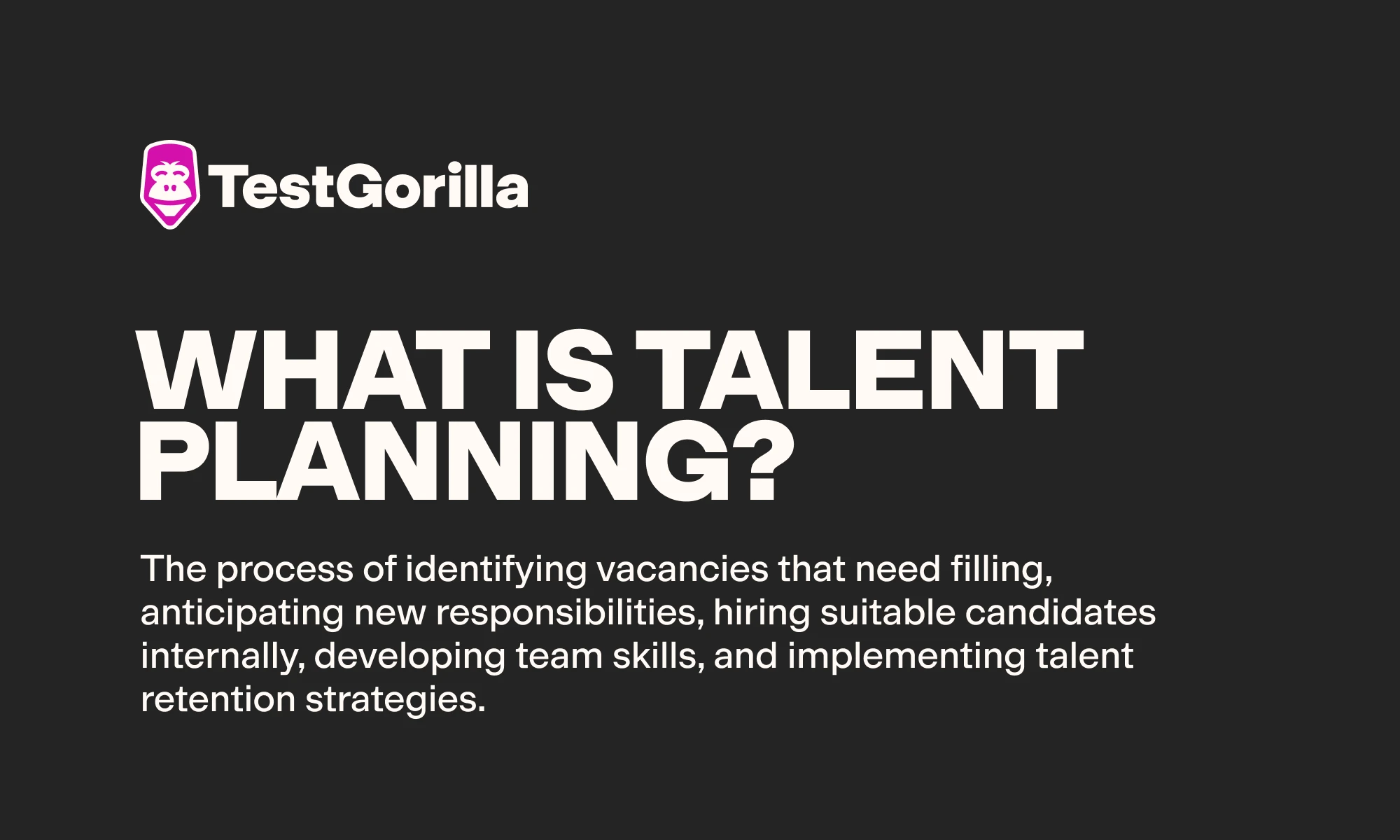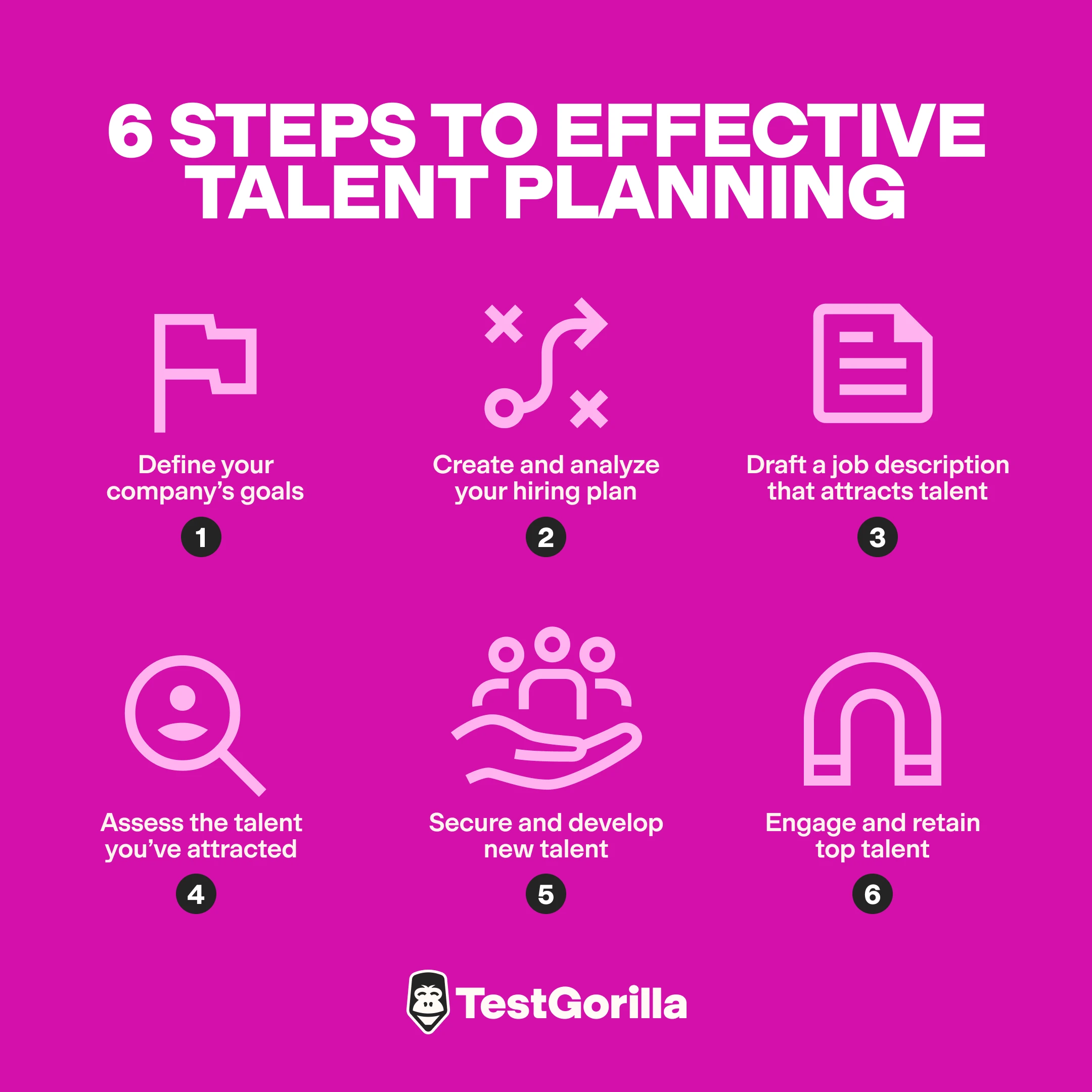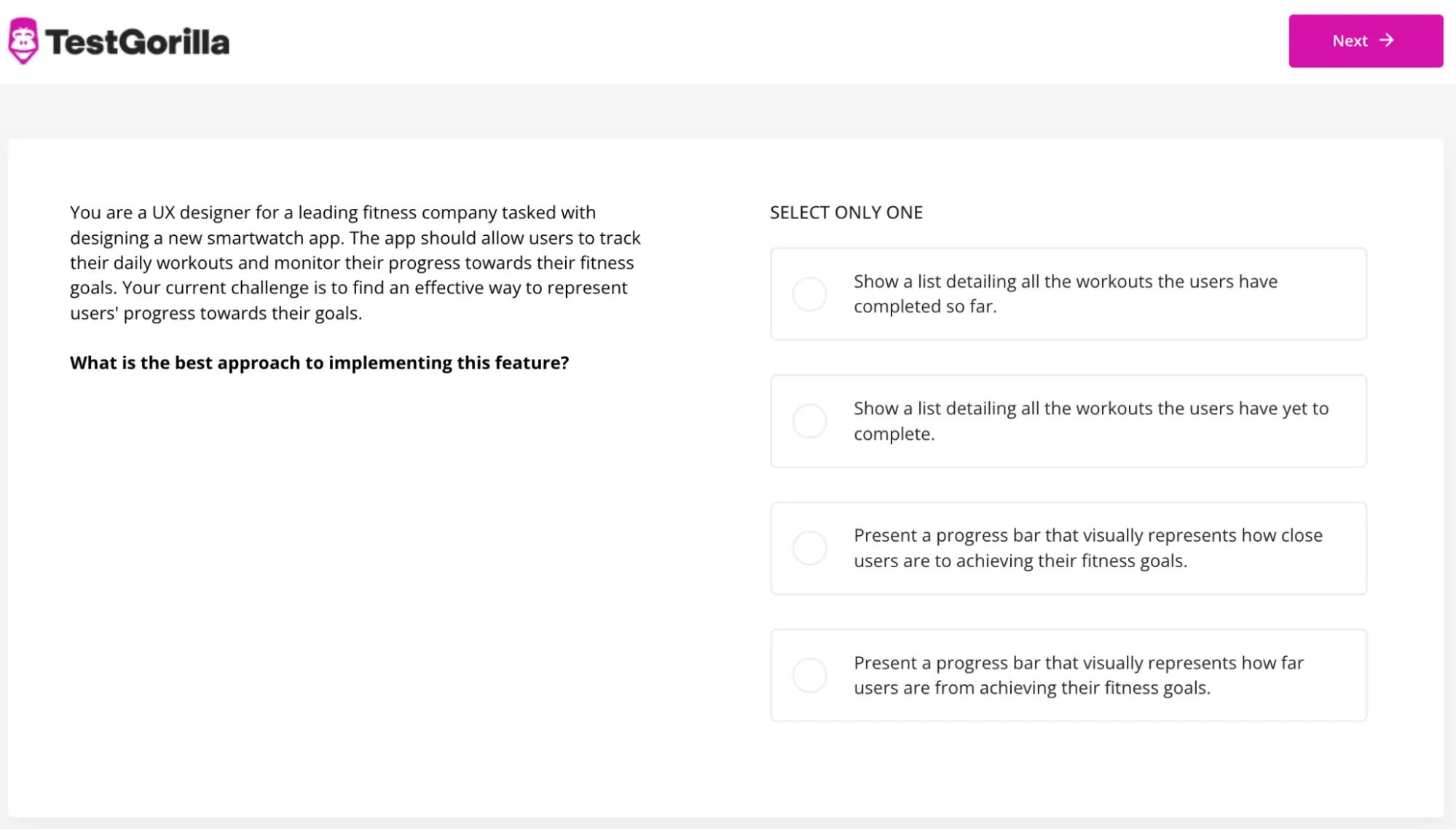Talent planning: Strategies and best practices for success
Level up your planning with talent assessments
HR technology trends, like automation, AI, and internal talent marketplaces, are causing a major occupational shift in the workforce. Moving forward, employers must hire based on measured, bias-free skills and competencies – rather than on-paper credentials – to keep up.
Focusing on skills helps you find top talent that fits your current and future needs to stay competitive in the long term.
But how can you discover and attract the candidates with the skills you need now and in the future? The best way to future-proof your talent needs is through a well-thought-out talent planning strategy.
Let’s see how effective talent planning and skills testing can set you up for future success.
Table of contents
- Talent planning definition: What is talent planning in HR?
- What are the objectives of the talent planning process?
- Why is talent planning important?
- What are the six steps to effective talent planning?
- The top talent planning tools
- Use skill assessments to establish your talent planning baseline
- Talent Planning FAQs
Talent planning definition: What is talent planning in HR?
Talent planning is the process of identifying vacancies that need filling, anticipating new responsibilities, hiring suitable candidates internally, developing team skills, and implementing talent retention strategies.
Typically, a talent plan considers the cost, management, and coordination of activities that lead to workforce development. A successful talent plan is comprehensive, understandable, and easily accessible.
Key stakeholders should be able to easily access your talent development plan so they can align with your business objectives.
When talent planning, you use talent mapping tools like skill assessments to determine and fill skill gaps. Identifying your workforce's talent baseline is the first step to aligning your workforce planning with your business goals.
Talent is vital to building and maintaining a successful business. Around 60% of middle-market executives now place talent planning among their top priorities. Next, let’s examine the different objectives employers seek to achieve through talent planning.
What are the objectives of the talent planning process?
Knowing what talent is missing in your organization is only half the battle. You must also consider your future hiring requirements and build a plan in advance.
Here are the four objectives of talent planning:
Objective | Summary |
1. Align business strategy with talent planning | Matching recruitment goals with short- and long-term business goals ensures that you’re hiring according to how your business plans to operate in the future. |
2. Build the correct talent management processes | Set up processes that enable talent planning, such as retirement and succession planning. |
3. Lead the talent planning process | Train managers on talent planning initiatives to lead from the top and make sure the process runs smoothly. |
4. Engage in the talent planning process | Use development and recognition to reward and engage talent. |
Now, let’s cover each objective in a bit more detail:
1. Align your business strategy with talent planning
Aligning your business strategy with your talent planning goals keeps you aware of what skills you need currently, which skills you’ll need in the future, and which skills will soon become obsolete.
Before you begin talent planning, it’s important to examine your in-house talent. Remember to use skill assessments to spot potential skills gaps before discussing your talent management strategy in each quarterly business meeting.
Establishing a talent baseline determines how your talent plan matches your overall business strategy. For example, if you’re aiming to increase your social media presence, you first need to identify what social media competencies you’re currently lacking.
2. Build the correct talent management processes
Any business framework is made up of smaller parts. It’s vital to create and implement correct processes for talent management, such as:
Making succession plans for the critical roles in the company
Expanding your talent pool within the organization
Planning your talent’s career paths
Noting the retirement dates of your top talent
Monitoring employee turnover to stay aware of any trends or risks
Staying comprehensive in your talent planning and associated processes minimizes unforeseen problems – and headaches – down the line.
3. Lead the talent planning process
Like most elements of running a business, talent planning can’t be done only by HR professionals. You need the help of the leadership team, but that means taking the time to get on the same page.
When leading the talent planning process, make sure senior leaders have the required knowledge about landing potential talent. If you don’t conduct truthful and open talent review discussions, your staffing goals may become misaligned among senior leadership and lack the support and funding you require to improve your organization’s human capital.
4. Engage your organization in the talent planning process
It’s important that every employee is engaged in the talent planning process because it’s about more than hiring the right talent – it’s about cultivating the right skills from the employees you already have.
Employee engagement encourages the development of necessary skills. It can be done by identifying and rewarding top performers, creating mentoring programs, and regularly testing your employees’ skill sets so they know how their improvement is faring.
Why is talent planning important?
The primary benefit of talent planning is that it helps you attract and retain top talent.
A survey found a lack of advancement opportunities was one of the top two reasons for leaving a job.
That means one solution to employee turnover is simple: Don’t let employees stagnate in their roles by actively guiding them down their career path. A talent development plan molds your workforce into a team that excels and progresses into higher roles.
Effective talent planning identifies and bridges skills gaps. A good talent plan ensures that your organization always has enough skills to thrive. By identifying gaps with skill assessments, you can focus on driving the company’s success.
Talent planning also prepares your organization for the future. You’re ready to manage the changes, obstacles, and opportunities that appear over time.
What are the six steps to effective talent planning?
Effective talent planning involves finding ways to develop your employees and new hires. You need to have a talent management model in place for your employees even before they apply for the post.
Here are the six steps in strategic talent planning:
Step 1: Define your company’s goals
The first step to building an effective talent planning strategy is to define your business goals. For example, are you planning to increase sales in a new market or create a more diverse workforce?
Laying out your goals clearly gives you a picture of what you want and need, paving the way toward achieving them.
Step 2: Create and analyze your hiring plan
Your hiring plan should lay out budget planning, the duration of the recruitment process, and your recruitment strategy. On average, the cost of hiring a new employee is $4,700. However, this cost varies with the organization’s hiring plan and can be reduced by focusing more on internal hires.
A hiring plan specifies not just the cost of recruitment but also the number and quality of applications your company needs.
Use skill assessments in the hiring process to ensure your hiring plan addresses skill gaps at the company level and not only at the job vacancy level. After all, talent acquisition is about acquiring talent for the long term, not simply filling roles.
Step 3: Draft a job description that attracts talent
Your job description plays a critical role in the number and quality of applications you get. Therefore, you must draft a clear and compelling job description that attracts the best talent among potential applicants.
Carry out a job analysis for every vacancy to fully grasp the competencies needed for the role.
Any job description should include:
The responsibilities of the role
The duties expected of the employee
The skills required to perform the role
To make this step a little easier, consider using a job description template.
Step 4: Assess the talent you’ve attracted
You can assess the talent you attract using pre-employment assessments and interviews. Pre-employment assessments let you evaluate each candidate’s skill, experience, and personality. They usually come after applicants initially apply but before interviews.
For example, you could use the Human-Computer Interaction Design test to hire UX or web designers.
Then, move on to structured interviews with the high-performing applicants. Interviews give you one-on-one experience with candidates and enable you to more closely examine the candidate’s personality and reaction to various situations.
Sign up for the TestGorilla free forever plan and empower your talent planning with pre-employment assessments.
Step 5: Secure and develop new talent
After assessments and interviews, the next step is to offer the post to successful candidates. Once they accept, start drafting a tailored talent development plan.
To develop talent, you must provide your employees with learning and development opportunities. Encourage them to participate in talent assessments that identify their strengths and weaknesses and empower managers to optimize their training plans.
You should also offer them mentorship and coaching from leaders in your organization.
Step 6: Engage and retain top talent
Only 33% of workers feel engaged in their work and workplace. Don’t leave untapped potential on the table; build a development and talent retention plan.
Let your employees voice their opinions and share their ideas with employee suggestion boxes and feedback surveys. Encourage open communication with team messaging platforms and use peer recognition apps.
These not only boost workforce collaboration but also help improve their communication and interaction skills.
More engaged employees stay with your business for longer and lower your overall hiring costs. You can also invest in strategies to reward and retain high-potential employees in your company.
The top talent planning tools
Talent planning doesn’t need to be overwhelming; several types of talent planning tools are available to assist you.
Skills-testing platforms
Skills-testing platform tools like TestGorilla make it simpler to identify your current employees’ strengths. These talent planning tools contribute to your talent development or reskilling so that you can plan for changes to your organizational structure.
For instance, you may need to appoint a new marketing manager after adding a marketing department branch to your company.
From our online testing platform, simply click the “create new assessment” button and then type “marketing manager” into the job role bar. Add a few more details and then wham – you have a premade skills assessment template ready to go!
It’s also a cinch to customize skills tests. For example, if you need to test your current marketing manager's SEO abilities, you can just type “SEO” into the search bar and add and remove assessments.
Once you’ve identified an area for improvement, like SEO, you can focus on upskilling this particular employee, turning weaknesses into strengths.
Find out how easy it is to customize skill assessments by booking a TestGorilla demo.
Workforce planning tools
Who likes using spreadsheets?
Very few of us, which is why many businesses have evolved beyond Excel and use workforce planning tools to simplify talent planning and automate manual data entry tasks related to talent management in real time.
With workforce planning software, you can also view critical talent planning metrics, making it a breeze to keep each department churning over with the right amount of employees.
This software gives you insight into how to allocate team members for each project or shift to ensure that those with the ideal skills are completing the right tasks.
Learning management systems
What better way to organize employee training and development than with a ready-made app? Learning management systems can streamline team member career development, employee education, internal recruitment, onboarding, and succession planning.
Integrating a learning management system into your talent planning process can help you organize learning processes and manage employees’ performance with a single application.
Talent planning template
Organizations complete the talent planning process by implementing a framework of objectives supported by written documents.
Why start from scratch when you can use a talent planning template?
Below is a simple template that lists the information you should record if you want to implement a talent planning process and achieve your company’s goals.
Team name:
Team function:
Manager: [The talent planner overseeing the development plan]
Team members:
The goals of the plan: [List out the objectives of the talent management plan. Include short-term, medium, and long-term goals for the current team members and potential replacements]
Requirements to be completed: [Create a list of duties, responsibilities, milestones, and competencies and the expected dates of completion]
Current team member in the role:
Team member to assume the role: [Summarize your talent management succession planning. Indicate whether roles are to be filled internally or externally from recruiting.]
Time assigned to be role-ready:
Skills, knowledge, and experience to develop:
Use skill assessments to establish your talent planning baseline
Your people are the foundation of your business. Talent planning helps you expand that foundation with the right people and in the right direction for company growth.
You can’t even think of implementing talent planning strategies without using skill tests to identify gaps in your workforce and establish a talent baseline. Once you know what’s needed to fill the gaps, use pre-employment assessments with TestGorilla to eliminate unconscious bias and find the best candidates.
Sign up for a demo and find out what TestGorilla assessments can do for your talent planning strategies.
If you’re itching to get going right away, then try out our free forever plan and start building your first talent assessments today.
Talent Planning FAQs
What are talent planning activities?
Talent planning activities include in-house skill assessments, learning and development, targeted recruiting with pre-employment testing, and mentorship activities. Human resources professionals use talent planning processes to shore up skill gaps, fill vacancies, develop team members, and have succession contingencies in place.
What are the 7 components of talent management?
Recruiting activities, such as posting roles on job boards and skills-based hiring
Admin activities, such as making offers and setting start dates
Professional development, such as coaching and mentoring
Team member engagement strategies, development planning, and collaborative meetings
Performance management tasks, such as manager feedback and employee surveys
Team member recognition programs like team lunches, gifts, and other awards
Succession planning with talent mapping and individual development plans
How do you develop a talent plan?
Define your organizational objectives
Use skills assessments to identify upskilling and reskilling opportunities
Provide a diversity of development opportunities
Create a talent development strategy that aligns with your workforce planning
Give every team member a unique career development plan
Establish a culture of continuous improvement and education
Get leadership on board with talent planning
Train managers to implement your strategy
Gain the support of key stakeholders
Continuously monitor, analyze, and improve your talent planning strategy
Related posts
You've scrolled this far
Why not try TestGorilla for free, and see what happens when you put skills first.
Latest posts
The best advice on pre-employment testing, in your inbox.
No spam. Unsubscribe at any time.

Hire the best. No bias. No stress.
Our screening tests identify the best candidates and make your hiring decisions faster, easier, and bias-free.
Free resources
This checklist covers key features you should look for when choosing a skills testing platform
This resource will help you develop an onboarding checklist for new hires.
How to assess your candidates' attention to detail.
Learn how to get human resources certified through HRCI or SHRM.
Learn how you can improve the level of talent at your company.
Learn how CapitalT reduced hiring bias with online skills assessments.
Learn how to make the resume process more efficient and more effective.
Improve your hiring strategy with these 7 critical recruitment metrics.
Learn how Sukhi decreased time spent reviewing resumes by 83%!
Hire more efficiently with these hacks that 99% of recruiters aren't using.
Make a business case for diversity and inclusion initiatives with this data.























